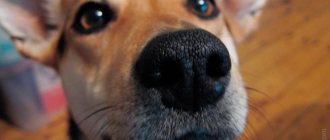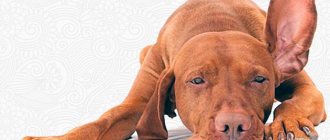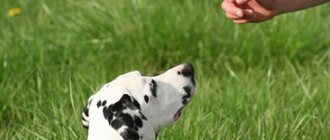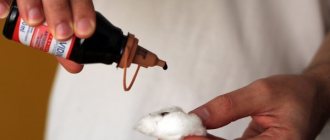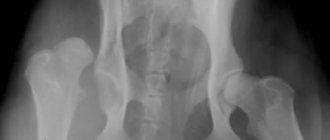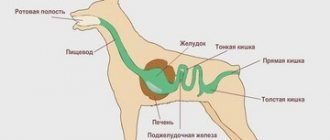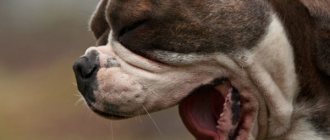Why should they be installed?
It is necessary to put ears on dogs so that the pet does not raise doubts about its elite status. Erect ears give animals a more aesthetic and impressive appearance. This issue is especially important for exhibition animals.
If the identified defect of lop ears is not a congenital defect and was not obtained as a result of injury, then simple manipulations will help correct the situation (in other cases, the help of a veterinarian and surgeon will be required).
Some dog owners do not consider ear studs necessary. Moreover, the standard of many breeds allows them both standing and hanging positions. In any case, the choice remains with the person, and the dog is completely indifferent to what ears it has, because this will not affect its devotion and love.
How to put on a dog's ears
There are many different breeds of dogs and the most important thing is that they all have their own characteristics. For example, you may not know how to properly position your dog's ears. This is done only for aesthetic reasons and has absolutely no functional meaning. This can only be done occasionally for hygiene reasons. So this is how this procedure is performed. Let's start with the fact that it is performed after ear cropping, if you decide to use cropping at all. Further, we note that this procedure is most needed by Yorkshire terriers, shepherds, chow-chows, huskies and other similar dogs. It happens that the ears of these breeds stand up on their own, but in most cases it is necessary to perform a whole set of actions that leads to the desired result. There are enough subtleties in this matter, so let’s move on.
How to properly position a dog's ears
You can do this at home.
In principle, you will only need to gain experience, which will be the basis of your skill. A lot of patience will also be very helpful. The procedure is performed when the puppy is 3-4 months old. Here are the actions we need to get the desired result: 1. add a sufficient amount of calcium to the dog’s diet, but be careful not to have too much of it.
2. Truly effective strengthening of ear cartilage occurs by adding gelatin to the food.
3. We don’t let the dog scratch its ear, we carefully monitor it and try to wean it off.
4. Part of the time you won’t need to touch the dog’s head.
5. The hair on the ears will need to be trimmed regularly.
6. There is a special ear massage technique that we will need.
7. In some cases, the ears will need to be glued.
The most unusual, both by ear and in practice, is the procedure of gluing the ears. Perhaps you have heard about it, then you already know that it is needed only as a last resort, if all the previous points have been completed, but it did not give any result. We will need to clean and degrease the ears of our shaggy friend. The next step is to use textile glue, which is ideal for then separating the ears. In addition, patches are excellent, but it is important that the dog does not feel irritation. The third option is a wire crown. If we talk about the patch, this is now the most popular option. We will need to cut the small patch into squares. The first of them will need to be glued to the inner surface of the ear, approximately at the base of the cartilage. Next, we will have to glue the pieces of plaster, moving upwards. You will need to make a special jumper between the ears, with which they will be held parallel. If you are interested in the wire method, then this is the use of a special, simple crown, which, by the way, can be purchased ready-made. Dogs can walk around with such a thing on their heads for several weeks without any problems, because they quickly get used to them and stop paying any attention.
Remember that you can get professional help. If things go really badly, you can find special announcements that are called something like “Let's put our ears on” - short and clear.
We put ears on different breeds of dogs
For 90% of different breeds, this procedure is absolutely the same and this should not be surprising. Of course, there are some subtleties, taking into account which will also not be a superfluous parameter. For example, to really effectively set the ears of a Yorkshire terrier, a textile lei is enough, because the ears themselves are quite light and delicate - excessive manipulation with them will be unnecessary. There is one subtlety in this matter - you need to regularly trim your ears to give them a rest. If you do this once a week or twice a week, then the ears will be in the right position, and the dog will not worry unnecessarily.
If we talk about Dobermans, then you will have to suffer. You may have already come across stories about how many problems there are with this. This is the honest truth, so you need to act as carefully as possible. You should start within a day after cupping. Here we will need a crown made of wire, besides, the Doberman is an active and playful dog, so you will need to make sure that the crown is on your head all day long.
It is important to remember that even the most detailed manual will not tell you all the details about this procedure - you need consultations with veterinarians and breeders. Practice shows that even a conversation of 10-15 minutes after the cupping procedure will give you a much better understanding of what needs to be done than much more time spent on independent trial and error. These rules are not difficult to follow, so don’t delay seeking professional help.
Why they don’t get up - reasons and solutions
Newborn puppies are born with small ears pressed to their heads. As the animal grows, they straighten out, the cartilage strengthens and they take on a vertical position.
The time has come, but the dog’s ears don’t stand up. Why? The answer to this question is often of great concern to owners. The process of ear raising is influenced by five main factors:
- Genetic inheritance.
- Unpurebred (mixed puppies).
- Lack of calcium in the body.
- Too thick (fleshy) ears.
- Thin and weakened.
The main thing is not to panic and not to give up. Problematic ears need human help and can be fixed. The set of activities includes:
- proper nutrition;
- special vitamins;
- manual massage;
- ear gluing.
Nutrition
If the puppy's diet does not have enough calcium, or he did not get enough of it through his mother's milk, his ears may droop. In this case, you need to review your pet's menu.
Small breed puppies born from bitches who have suffered from postpartum eclampsia (loss of calcium in the blood) will most likely have problems with ear placement!
You can add calcium to your dog’s body using natural goat’s milk or calcium-enriched cottage cheese. It is not difficult to prepare it at home.
Recipe for making calcined cottage cheese
Edible gelatin, which can be added to the puppy’s food or prepared aspic dishes based on it, will help your dog replenish the lack of calcium.
Excess calcium in a pet’s body is no less dangerous than its deficiency. In this regard, it is important to comply with the daily norm of its consumption.
Vitamins
To strengthen cartilage tissue, special vitamins should be added to the puppy’s main diet: Excel, Polydex, Canina, Beafarm, Calcefit, Volmar, Kanvit. Vitamin “Steed Plus” is good for lifting weak ears, but it is quite expensive and you can’t buy it in every store.
“Silver Trail” Calcium Peptide is a little-known Russian brand. Its natural composition and nano-method of supplying calcium to the bone and cartilage tissue of animals receive the highest marks from experts.
Before purchasing and using zoovitamins, you must consult a veterinarian.
Massage
Massage is an additional measure to solve the problem of drooping ears. It helps in combination with nutrition and vitamins. It is not difficult to do, and the dog perceives the massage as if it were affection.
During this time, the puppy should not be distracted and should be completely relaxed. Grasp the base of your baby's ear with your thumb and index finger. Using kneading massage movements, work the cartilage itself and move towards the tip, slightly pulling and directing the blade vertically. Perform several massage techniques at once in this way.
The massage will not harm the ears and the number of procedures during the day is unlimited . Thanks to it, blood flow increases in the tissues, which has a beneficial effect on the process of strengthening and maturation of cartilage tissue.
Methods for correcting ear setness and their effectiveness
Beginning breeders often believe that erect ears are a sign of the breed. However, “misfire” also occurs in purebred Chihuahua dogs, but much less frequently than in mixed breeds.
The puppy is separated from its mother at the age of 2-3 months. By this time the ears are already standing up or starting to stand up. It all depends on the individual characteristics of a particular animal. No help is required up to 4 months; with good genetic inheritance, the ears will stand up without outside intervention.
From 4 to 6 months, i.e. During the teething period, discuss with your veterinarian the prescription of calcium supplements (for example, Excel Calcium), and review your diet.
To strengthen the jaw muscles, gums and teeth, purchase specialized commercial treats for small dogs. The leader on the Russian market is .
There is a possibility of affecting the ear position of a Chihuahua puppy between 6 and 8 months of age. During this time period, make your maximum efforts. The older the dog, the lower the chances of solving the problem in a conservative way.
Today, Internet users actively recommend the following posture correction methods:
- regular massage of the base of the auricle;
- diet with mineral supplements;
- gluing the ears with a fixing plaster;
- surgical correction of posture (otoplasty).
There is no scientific evidence that massage helps strengthen ear cartilage! On the contrary, careless actions of the “massage therapist” can lead to damage and kinking of cartilage tissue.
A diet with mineral supplements has its place, but I do not recommend resorting to it without first consulting a veterinarian.
Surgical plastic surgery of Chihuahua ears is usually performed for cosmetic defects of the auricle. The operation is performed under anesthesia. Average cost of otoplasty: 10,000 rubles.
Gluing the ears of a Chihuahua is the most gentle and effective method of correcting posture. The maximum effect is achieved in combination with the use of calcium supplements, which strengthen the cartilage of the dog’s auricle.
Bonding - pros and cons
The “gluing” method helps to radically make your puppy’s ears droop. It has proven itself in practice and is widely used for installing cropped and undocked ears on various breeds of dogs.
Some pets behave excitedly after gluing. They try to rip off the bandage and the structure with their paws, and rub their heads against the furniture. This way they can damage the ear cartilage and make the situation worse. In this case, you should loosen the tie and wrap or put on a special protective “collar” for the puppy.
Sometimes, after removing the adhesive plaster, an allergic reaction, pimples or scratches are clearly visible on the ears. Suitable for their treatment:
- baby powder;
- hydrogen peroxide;
- pharmacy blue.
After the ears have rested, the wounds have healed, and the crusts have dried, you will need to repeat the gluing procedure.
The “gluing” method is completely safe for the physiology of the animal and has no contraindications. This procedure should be carried out carefully, observing all preparatory and main steps.
Types of ears
Different dog breeds have different ears based on the following criteria.
By shape
Depending on the shape of the tips, the ears can be pointed (for example, like a German Shepherd) or rounded (typical for Bassend Hound dogs).
According to the strength and structure of cartilage
In this case, the ears are classified as:
- standing (fully raised above the head);
- semi-erect (the cartilage is strong only in the lower part of the ear, and closer to the tips it becomes thinner and more elastic, causing the ends of the ears to bend down);
- hanging on cartilages (the base of the ears has strong cartilage, but the main part of the ear hangs down - the fold line runs approximately at the level of the forehead);
- hanging (ears hang immediately at the base, without forming a clear break line).
By size
Relative to the size of a dog's head, erect ears can be large, medium, small or small, while floppy ears vary in length and width.
By delivery
Ears can be wide-set, close-set, floppy, high-set, or low-set.
By other criteria
The degree of development of the subcutaneous tissue of the ears (fleshy, folded, dry, heavy), the degree of fouling of the ears with hair, their mobility and other criteria are also taken into account. There are heart-shaped, tulip-shaped, triangular, and even rose-shaped ears.
Each of the listed qualities can determine not only the dog’s compliance with breed standards, but also its temperament. Thus, moving, pointed ears usually indicate the dog’s lively and spontaneous character, sometimes its insatiable curiosity. And low-set, “burdock-shaped” ears often indicate a phlegmatic and philosophical nature of the pet. But this is not always the case, and an enthusiastic beagle with floppy ears may turn out to be more active than a timid Yorkshire terrier. But if all ears are so different, how to properly care for your dog?
Staging methods
Ear fitting for dogs is carried out using soft and hard structures. Both methods have the same goals and similar execution techniques, but differ from each other in the materials used.
Rigid design
The rigid design is used for large dog breeds and long cropped ears. You can make it yourself from scrap materials or buy it at a pet store. To create a basic hard “crown” you may find it useful:
- foam rollers for the liner;
- medical glue will help to glue the curlers;
- a pencil so as not to get your hands dirty;
- Popsicle sticks for rigidity and as a guide line;
- General fixation will require medical or surgical tape. Reinforced construction tape or masking tape will also work.
Make sure that the glue does not get into the animal’s ear canals and do not forget to first remove hair from the ears and degrease them with an alcohol solution.
Soft design
This setting option is suitable for small breed puppies. It provides for gentle gluing without glue or complex rigid fixations. Making gluing using a soft structure is not difficult.
The necessary materials are a 3 cm wide adhesive plaster and cotton swabs (for rigidity). As in the first case, the fur from the ears must be shaved off and the ears wiped with alcohol, otherwise the procedure for removing the adhesive tape will cause pain to the puppy.
There are many options for gluing and setting ears. Any materials can be used: sanitary tampons, cut-outs from plastic cards, pen refills, plastic bottles and foam sponges.
The main rule is do no harm. It is important that the devices do not injure the puppy, are durable and light, so that they are easy to install and not difficult to remove.
How to glue a dog's ears There are many ways to glue an ear that cannot stand on its own. And you can use any that is convenient for you, except for those when something is glued directly to the living tissue of the ear with toxic technical adhesives, like Moment glue. These industrial adhesives are poisonous and are absorbed through the skin, causing great harm to the puppy. (We will also use “Moment”, but for gluing the cardboard to the adhesive plaster.)
I like the method described below because it is simple, accessible to everyone, and, most importantly, does not interfere with blood circulation and is gentle on the dog’s ear.
What needs to be done: 1) Determine the weak point of the ear (Fig. 1). 2) Place a piece of adhesive tape inside the ear (Fig. 2). 3) Glue a cardboard patch onto the adhesive plaster. It will cover the weak spot and give strength to the auricle (Fig. 3). 4) Secure the cardboard patch on top with a second piece of adhesive tape (Fig. 4).
How to determine the weak point of the ear First you need to determine whether you need to glue your ear or whether you can do without gluing.
To do this, use the tips of two fingers (thumb and index) to feel the auricle. By pinching the ear from the inside and outside between your fingertips, you can determine the weak point of the ear. The cartilage there is thinner and softer than in the rest of the ear. - This is either a small “spot” or a stripe.If you press this spot (or a strip in the middle) with your fingertips and strengthen it, the ear will straighten and stand while you support it in this way.
If such a spot is located in the upper third of the ear, then gluing is not needed. On Vision products it will rise and strengthen itself. If this is not a spot, but a strip across the entire ear and this strip is almost devoid of cartilage, then a crease has formed, and gluing is required.
If the weak spot is in the middle of the auricle, in the lower third or at the base of the ear, gluing is necessary.
Well, if the ears lie like “rags” on the head, and the weak point is the entire ear, or if the dog has persistent irritation to all types of gluing, then it is better to refer to the sections: for a puppy - The puppy’s ears do not stand up for an already grown dog - Not the ears of an adult dog are standing.
| Fig.1 Determine the weak point of the ear (marked in pink). If you strengthen this spot, the ear will stand up. Fig. 2 Place an adhesive plaster (highlighted in white) on the trimmed (or shaved) and degreased area of the ear. Fig.3 On the adhesive plaster we glue a “patch” made of cardboard (highlighted in blue) the size of which is slightly larger than the “weak” spot (pink dotted line) Fig.4 Cover the cardboard patch (blue dotted line) with a second piece of adhesive tape. The weak spot (pink dotted line) has been strengthened. |
You need:
- a roll of ordinary medical adhesive tape on a fabric basis. The width of the adhesive plaster depends on the size of the ear. You can figure out which adhesive plaster you need to buy by looking at Fig. 2. For shepherd dogs, I use adhesive plaster 3 cm wide. This is the height of the desired piece of adhesive plaster, and I cut 2.5 cm wide from the roll;
- a small piece of thick cardboard. Corrugated cardboard from packaging is best. It is three-layer, thin but durable. Does not injure the ear with hard edges! It is important that a patch made from this cardboard will not break or bend under the weight of the ear and that this cardboard can be easily cut with ordinary scissors;
- just a little vodka or medical (ethyl) alcohol to degrease the adhesive plaster and the ear area;
- “Moment” glue (preferably one that provides a flexible connection, such as shoe glue); - Attention! We will not lubricate bare skin with it, but an adhesive plaster.
- scissors with thin blades or a razor for shaving;
- a few pieces of cotton wool;
- a little of your patience.
Operating procedure:
- Preparation for gluing.
- 1.1.
Determine the weak point of the ear as described above. See Figure 1. - 1.2.
Cut out a patch from cardboard that is slightly larger than the weak spot as in Fig. 3. Round the corners of the patch so that they do not injure the ear. - 1.3.
Cut the required piece from the adhesive plaster as in Fig. 2. Trim the corners of the adhesive plaster - this will make it easier to place it inside the ear. - 1.4.
Prepare another similar piece of adhesive plaster. - Applying an adhesive plaster inside the ear.
- 2.1.
Plug the ear canal with a piece of cotton wool to prevent hair from getting cut there. Trim it very short (use scissors with thin blades) or shave the fur inside the ear where you will stick the adhesive plaster. The shorter the wool is removed, the better and longer the patch will last. The trimmed area should be slightly larger in size than the adhesive plaster. This will make it easier for you to glue it. - 2.2.
Wipe the cut area with a cotton swab soaked in vodka. This will degrease the skin and remove hair particles after cutting. - 2.3.
Use the same cotton swab to wipe the sticky side of one of the pieces of adhesive tape. The adhesive plaster prepared in this way can then be removed without damaging the delicate skin of the auricle. - 2.4.
After the skin on the ear and the adhesive plaster are dry, stick the adhesive plaster inside the auricle as in Fig. 2. Press the adhesive plaster firmly against your ear, smoothing out any wrinkles. - Gluing a cardboard patch.
- 3.1.
Lubricate the cut cardboard patch (see section 1.2) on one side with Moment glue. - 3.2.
Also lubricate the area of the adhesive plaster on which you will glue the patch with the same glue. Do not leave your dog unattended. Hold your ear with your hands for a few minutes to prevent the glue-coated area from sticking to anything. After 10 minutes, glue the patch to the adhesive tape. - Securing the cardboard patch with a second piece of adhesive tape Cover the cardboard patch with a second piece of adhesive tape, smoothing it tightly to the cardboard and to the first adhesive tape. This second adhesive tape holds the cardboard in place and protects it from getting wet when it rains.
Now you can let go of your ear and admire what happened. AND…
Attention!! - A cruel disappointment awaits you: The ear, which stood so well while you pinched the weak spot with your fingers and which you so carefully sealed, will fall and look ridiculous and hopeless! It's just that the muscles of the ear are not used to supporting the ear in a standing position. - Don't touch your ear. After some time (about an hour or a little more), it will get used to the new sensations and gradually begin to acquire the desired position. This is another “plus” of this method of gluing - the ear muscles begin to work.
Most likely, the ear will not immediately acquire an ideal position, but now this is not at all important. Now only one thing is important: that the ear does not bend in a weak spot.
Vision products and the dog's genetics will do the rest.
One more warning: it is very possible that the first time the adhesive will fall off very quickly, sometimes almost immediately. This happens:
- if you cut the hair with scissors with thick blades and stubble remains on your ear. Take it off and cut or shave off this stubble and tape the ear again;
- if you have not properly degreased the skin or have not properly removed particles of cut hair. In this case, you will see them on the loose adhesive tape;
- if the adhesive plaster is old and does not stick well. — Buy a new one at another pharmacy;
- It just didn't work out. - Try again, experience here is gained very quickly, and everything will start to work out.
Normally, the patch lasts from one to two weeks and falls off on its own, completely or partially.
Once the patch no longer supports your ear, remove it. Let the skin breathe a little, if necessary, trim the overgrown hair. Before cutting a new patch, feel the weak spot. Maybe the size of the new patch can be reduced. But it won't be right away. Using recommendations for gluing the ear and other recommendations in the Correction section. Dog Ears You can quickly and easily strengthen the problem ears of a puppy and even an adult dog. Gluing the ear helps it rise, but it is not it that restores the ear cartilage, but Vision products. To do this, it is enough to get an individual consultation and then purchase the recommended products through our website (Buy).
Step-by-step instructions for installing undocked ears on small dog breeds
All small and decorative breeds have the same way of setting problematic, undocked ears. Let's consider it using the example of the Chinese Crested Dog, whose ears can be set on the 21st day of life. To do this you will need:
At the base of the auricle there is a delicate septum. Work carefully, ask another family member to help you, fix the pet's head . The noise and vibration of the machine can frighten him.
- Shave the hair on both sides of the ears with a trimmer. This will reduce their severity and ensure painless removal of the adhesive plaster. Remove any remaining fur from the edges with scissors.
- Wipe the ear with alcohol or any degreaser to make the patch stick better.
- Cut a piece from the adhesive plaster that is the length of the ear and place it on the table with the adhesive side down.
- Cut half a cotton swab and place it on the adhesive plaster.
- Place the second and third layers of adhesive tape on top of the cotton swab.
- We cut out the resulting strong sizing according to the shape of the ear, with the cotton wool facing down, and glue it to the inside of the ear, so that the ear canal is visible.
- We wrap the ears like a tube, but not too tightly so that the animal is comfortable.
- We wrap the folded ear at the base of the cartilage around the circumference with adhesive tape. Do not bring your ears close to the top of your head, as this may cause them to be positioned incorrectly. The bandage should look natural.
- To prevent the ears from falling apart in different directions and leaning forward, they will need to be fixed horizontally. They need to be connected to each other so that they are vertical. We connect them with adhesive tape at the base.
The puppy needs to stay in this bandage for about 5 days. Then the patch is removed, carefully unwinding it and trimming the hairs of the fur with scissors. It happens that after the first gluing procedure the ears already stand up.
If the result of raising was not achieved, then after a 12-hour rest the ears are glued again in the same way until they become stronger and take a vertical position..
The Chinese Crested Dog has two varieties: hairless and powder coated. The ear placement pattern is the same for both. According to the standard, the hairless variety must have erect ears, while the puffer variety is allowed to have both erect and hanging ears. According to breeders, a puff with erect ears looks more impressive.
How and when should a puppy’s ears go up:
norm and deviations
All puppies, regardless of breed, are born with small ears pressed to the head. Then the ears straighten and begin to grow. Their size and placement changes.
In breeds with erect and semi-erect ears, the ear cartilage gradually becomes dense and elastic, and the ears begin to rise.
The size and shape of the auricle is completely determined by heredity, but the position of the ears is formed during the process of growth and is influenced not only by genetic factors, but also by nutrition. since the strength and elasticity of the ear cartilage largely depends on the intake of necessary microelements, vitamins and other substances into the body.
The ears of puppies of breeds with erect ears rise between the ages of 2 and 4-5 months.
Raising ears can take a variety of positions:
- hang in different directions (“helicopter”);
- lean towards each other (“house”);
- take different positions: the puppy holds one ear completely differently than the other;
- the most favorable position is when the tips of the ears are directed forward and gradually rise
- and etc.
Photo 1. Various options for the position of rising ears in puppies:
The pictures show the main variations in ear position in growing puppies. But others are also possible.
All of them are normal, and such puppies may have proper erect ears in the future.
Photo 2. Ears rising in dynamics (according to photo 1)
“helicopter” - “house” - different positions - tips forward
The puppy grows, the head grows, the distance between the ears increases, and the size of the ears themselves increases. At 4 months, a puppy’s ears are already close to the size of an adult dog’s ears. They seem too big for a puppy's head - what is called "to grow."
We put ears on a Yorkie
Let's put our ears on
We have a boy, three months old. The ears are not standing. Tell me how to properly seal them so that they stand up. We asked the veterinarian for advice and were told that the question was not for him. Please advise. We really want our Pet to have beautiful ears.
Answer: Buy a drug for strengthening cartilage with glucosamine and chondroitin from a veterinary pharmacy.
The girl is 3 months old and still loses one ear. We tried to glue it with textile glue, adhesive tape, but to no avail... (we give calcium every day).
We bought it at 2.5 months, the ears weren’t standing yet. Please tell me what to do.
Thank you in advance.
Answer: Carefully cut the hair inside and outside the ear to about 1/2 the length of the ear (the breeder should show you this), you need to glue the ears. It is necessary to give the puppy, for example, these vitamins (there are smaller jars).
If I were you, I would go to the breeder so that she could show you how and to what length of the ear to cut the hair and how to properly glue the ears. I use a silk patch “Omnisilk”, narrow 1.25 cm - sold in a regular pharmacy.
My puppy’s ears have been standing since he was 1.5 months old, and recently one fell off, I trimmed it, maybe not very well, but it never stood up, could there be other reasons for this?
Answer: Now the puppy is actively growing - there is a high consumption of calcium, after vaccination the puppies' ears may also fall, and the common reason is overgrown hair on the ears.
Our Yorkshire is 4.5 months old, but her teeth are not changing and her ears are not standing up, but hanging like burlap. Maybe they are docked?
Answer: If the ears do not stand up at all, then it is quite problematic to install them already at this age; it happens that during the change of teeth the ears fall off, at which time they need to be glued. Yorkies do not have their ears cropped, but there are doctors who perform plastic surgery and install ears. In any case, you need to consult with a veterinarian, who will tell you what additional food to feed the puppy, how to properly glue the ears and whether such an operation is necessary.
